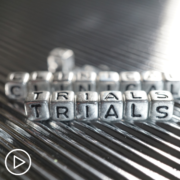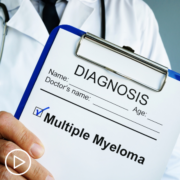Targeting of Myeloma Disease Progression and Bispecific Antibody Advantages
Targeting of Myeloma Disease Progression and Bispecific Antibody Advantages from Patient Empowerment Network on Vimeo.
How can myeloma progression and bispecific antibodies be used for myeloma care? Expert Dr. Ola Landgren from University of Miami Sylvester Comprehensive Cancer Center discusses how disease progression and genomic features can be targeted and the role that he perceives for bispecific antibodies in myeloma care.
Download Guide | Descargar Guía
See More from START HERE Myeloma
Related Programs:

|

|

|
Transcript:
Lisa Hatfield:
Dr. Landgren, what are the key biological processes driving disease progression and evolution of multiple myeloma, and how can we target these processes to prevent disease relapse and improve long-term outcomes?
Dr. Ola Landgren:
So that’s a very good question. So I think in a nutshell if you use genomics, which refers to the genetic changes that you can see in the plasma cells, there are certain features that the myeloma cells have. They have the copy number changes, that’s the gains and losses of chromosomes. You can find these if you do FISH and cytogenetics could be, for example, gain of chromosome 5 or gain of chromosome 7 or gain of chromosome 11. That would be part of the hyperdiploidy disease, or you have loss of chromosome 13 or 13q deletions. We also refer to 17p deletion. These are copy number changes, they’re extra or loss of these chromosomes. But then you have also the structural variance where you have the translocations of chromosome 14, chromosome 14 harbors the IGH locus, which regulates the making of immunoglobulins.
Plasma cells make immunoglobulins. For reasons that are not entirely clear. The translocations in myeloma that include IgH, they are partnering up with oncogenes. There is a list of oncogenes, there’s MATH, there’s three MATHs, A, B, C. There’s FGFR3, MMSET, and there’s also Cyclin D1 that are on the list. So these are the different types of structural variants that you can see with FISH probes. What people have understood less about are something called mutational signatures. And myeloma is made up by eight distinct mutational signatures that you can see in every single patient. And what that means is that you can, if you conduct whole genome sequencing and you look at all the base pairs, you can see there are certain number of combinations. C can be swapped for A and C can be swapped for G or C can be swapped for T, T can be A and T can be C and T can also be G.
Those are the combinations. So there are four different base pairs, but if you, because the DNA is double-stranded, these are the only possibilities that mathematically that you can see. Now if you look for every base pair and you look on one base pair on the left and one on the right, we call that 5 and 3 prime, you look through triplicates, every of these base pairs can have these different swaps I mentioned. Mathematically, there are 96 different combinations that you can come up with. That’s it.
If you don’t go through the entire genome from left to right, you see that there are these recurrent eight signatures that are there in every patient. So although we don’t understand why they are and exactly how they function, the fact that you see them in every patient tells us that this has to have something to do with the biology of the disease. It must have a role in the control of the disease. We are starting to see that there is one signature that’s called APOBEC. That signature seems to be very important for resistance to treatments. And you can see that APOBEC can be more or less expressed.
And if APOBEC is very expressed, we see that there are lot of mutations in the cells. We have seen in patients with the chemotherapy that APOBEC can be very expressed. When we treat with four drug combinations, it can be very expressed. And what I’m saying, when I say it can be expressed, these are in the patients that relapse out of these therapies. We have also seen that in CAR T cells and bispecifics. So that makes me believe and our group believe that the cells use some form of what we call tumor intrinsic defense mechanism to protect themselves from whatever therapy we use.
It doesn’t matter if it’s immunotherapy, chemotherapy or small molecule therapy, there are some fundamental programs the cells can turn on. We need to understand that better and we are spending a lot of time trying to drill into this. Lastly, I also want to say there was a fourth class of genomic events called complex events that you can see in myeloma, something called chromothripsis. That’s a very severe genomic lesion, is a ripple effect through the genome. There are a lot of havoc going on. And the first time we saw that, we thought this has to be something wrong with this sample. But when we look through more and more samples, we see that about a quarter of the patients actually have this chromothripsis.
So the bottom line is, it’s time to stop doing FISH, it’s time to do more advanced sequencing, ideally whole genome sequencing, but a step towards a whole genome could be to do whole exome sequencing. But there are companies saying that you can do whole genome sequencing for $1 in the future. So that’s really what needs to happen. We need to have better tools to better understand and then we can use this to better understand how to differentiate the therapy and have an individualized treatment. That’s what I talked about with the IRMA model.
Lisa Hatfield:
All right, well, thank you so much for that explanation. Dr. Landgren, can you speak to the advantages that bispecific antibodies offer over traditional therapies, and how do you see their role in overcoming treatment resistance?
Dr. Ola Landgren:
Well, the bispecific antibodies is a novel way of engaging the immune system to go after the myeloma. So if you think about the other antibodies we have, we have three other antibodies. We have daratumumab, we have isatuximab (Sarclisa), we have elotuzumab (Empliciti), they are naked antibodies. They bind to the myeloma and on the backend of these antibodies, there is something called the FC receptor that attracts cells, NK cells, for example, also T cells, and they also attract, some of these antibodies also attract complement and they also by themselves send what’s called a death signal into the myeloma cell.
The bispecific antibodies are very different. They bind and they don’t send death signals, they don’t engage with the complement. What they do is that they have another arm sticking out that binds to the T cells. That’s a CD3 arm and there’s an open pocket. So when a T cell passes by, it grabs the T cell. And now you have a T cell linked to the antibody sitting next to the myeloma cell and the T cell will kill the myeloma. T cells can be very aggressive and kill the myeloma. You just hold them together, it’s like a matchmaker.
And if you think about how CAR T-cell therapy is designed, you take out the T cells, you manufacture them to have a special antenna receptor on their surface, and then you give them back again. And then they bind, this receptor binds to myeloma cells. So in the setting of a CAR T-cell therapy, the T cell sits next to the myeloma cell, but that’s because the T cells were taken out of the body, manufactured to have this receptor that then finds the myeloma cell. But the bispecific antibody, that they don’t require the T cells to be taken out, to be modified this way.
You just use your existing T cells in your body and these antibody just binds to the T cells and the myeloma cells in the body. So it’s sort of a little bit mimics what the CAR T cells do, but it does it in its own way within the cell, within the tissue in the body. You asked me for resistance mechanism and how they are better. Well, I think the best answer I can give you is to say that the overall response rate for the bispecific antibodies are very high. They are 60 to 80 percent single drug compared to the current trials. And if you look and see the trials that have led to approval for the other existing drugs, they were 20 or 30 percent.
So the overall response rate is much higher for the bispecifics than they were for the other existing drugs. We don’t really know exactly how to use them, I would say. What’s the optimal dosing schedule? We give them weekly, it may be every other week, and maybe monthly, eventually, I would think. And should they be combined with which drugs? That’s ongoing investigation. Other questions are, can they be stopped? Can you monitor patients off therapy for a long time? Will some patients never have the disease coming back? We hope so, but we don’t know. Or would it be patients could be off therapy for a long time, like with CAR T cell? Could that happen with the bispecifics? It’s possible.
And if you were to monitor with blood-based tests and you see that there is reappearing disease, would you then put patients back on the therapy? These are questions we…there are a lot of questions, we don’t have answers to all these, but that’s where I think the field is going. A lot of people, including us, are trying to investigate this.








